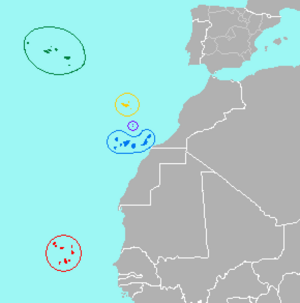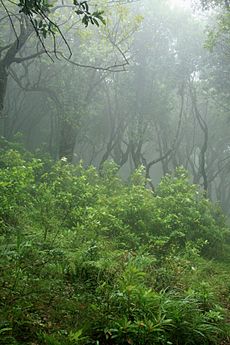Macaronesia facts for kids
The Macaronesian islands, or simply Macaronesia is a modern name for several groups of islands of volcanic origin in the Atlantic Ocean off the coast of Europe and Africa. They belong to three countries: Portugal, Spain, and Cape Verde.
Contents
Origin of name
Macaronesia (Greek: makáron 'blessed', 'happy', nêsoi 'island'; 'blessed/fortunate islands'). This term was used by Ancient Greek geographers for islands to the west of the Strait of Gibraltar.
The modern use of the term Macaronesia goes to the botanist Philip Barker Webb in the 1830s for botanical descriptions. The name is occasionally misspelled "Macronesia" in analogy with Micronesia.
Islands included
The following groups of islands (archipelagos) are commonly counted as being part of the Macaronesia - from north to south:
- Portuguese islands
- Azores (
 Portugal): area 2,333 km2 (901 sq mi), population 245,746 (2012)
Portugal): area 2,333 km2 (901 sq mi), population 245,746 (2012) - Madeira Islands (
 Portugal): area 801 km2 (309 sq mi), population 267,785 (2011)
Portugal): area 801 km2 (309 sq mi), population 267,785 (2011)
- Azores (
- Spanish islands
- Canary Islands (
 Spain): area 7,493 km2 (2,893 sq mi), population 2,117,519 (2011)
Spain): area 7,493 km2 (2,893 sq mi), population 2,117,519 (2011)
- Canary Islands (
- Independent
- Cape Verde (
 Cape Verde): area 4,033 km2 (1,557 sq mi), population 523,568 (2013 est.)
Cape Verde): area 4,033 km2 (1,557 sq mi), population 523,568 (2013 est.)
- Cape Verde (
Spanish is spoken in the Canary Islands and Portuguese in the rest of the islands. Cape Verde was a colony of Portugal but it is independent since 1975.
Geography and environment
The islands of Macaronesia are volcanic in origin, and are thought to be the product of several geologic hotspots.
The climate of the Macaronesian islands goes from Mediterranean in the Azores and Madeira to arid in Cape Verde. The Portuguese archipelagos of the Azores and Madeira have a generally cooler climate and higher rainfall than the Canary Islands and Cape Verde.
Even if the distances between the different groups of islands are large, the plants and animals are similar and there are many endemic plants that are found only in these islands.
The islands have a unique biogeography, and are home to several distinct plant and animal communities. The laurel forests, known as laurisilva, of Macaronesia are a type of mountain cloud forest with species of a vegetation type which originally covered much of the Mediterranean Basin when the climate of the region was more humid and evolved to adapt to island conditions. These forests once covered most of the Azores, Madeira, and parts of the Canary Islands ("Canaries") between 400–1200 m altitude (the eastern Canaries and Cape Verde being too dry).
Conservation issues
Cutting the trees for timber and wood, clearing vegetation for grazing and agriculture, and the introduction of plants and animals by humans has displaced much of the native vegetation. The laurisilva has been reduced to small pockets. As a result, many of the endemic biota of the islands are seriously endangered or extinct.
Related pages
- Jérôme Petit et Guillaume Prudent, « Macaronésie », Changement climatique et biodiversité dans l’outre-mer européen, UICN/ONERC, 2008, p. 124-137
Images for kids
-
Remaining patches of Macaronesia's threatened primeval laurisilva forest (except in Cape Verde) were protected by EU law in 2001.
See also
 In Spanish: Macaronesia para niños
In Spanish: Macaronesia para niños





